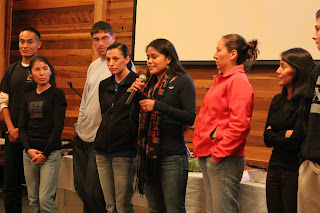This was quite the unusual type of event for me for many
reasons one; I’m a UW Husky and WSU Cougars are our mortal enemies, two; the
ladies on the opposing team are Umatilla, sister Tribes to the Yakama, and
three; my mom although a UW Graduate, is at heart, a Cougar from her WAZZU
Undergrad years. So, I was very excited to go, since the Yakama Nation Youth
Activities, LISTEN Program invited me and I played basketball in high school
and love it!
 |
| With the Wapato and Toppenish kids, and Patsy Whitefoot. |
The event was put on by the Lady Cougars Basketball Team and
I first heard about this game while at the WSU Fall Powwow this past October.
The Basketball Team made an appearance and invited all to come check it out.
They were to play against Louisville University, where Umatilla Ballplayer
Shoni Schimmel and her sister Jude Schimmel play. They’re family are the stars on
the recent film, “Off the Rez,” where their success story about basketball is
shared. In honor of recognizing the accomplishments of these ladies, royalties
were invited to attend and be recognized at half time. Yakama Nation Youth Activities
Program in conjunction with Johnson O’Malley, sponsored two Greyhounds to bus
people to the game in Pullman. My family and I enjoyed the ride with various
kids and other families as we jammed out to the films; Elf, and Coach Carter.
 |
| Wave! |
Basketball is a big thing in Indian Country and brings
families, and people together. Although I didn’t get to speak at this event, I
thoroughly savored every moment of the game—which was very close—reminiscing of
my younger years. Hanging out with Miss Pah-Loots-Pu is always fun, this year’s
WSU Powwow Queen is Chelsie Pratt, who hails from the Warm Springs Reservation.
All our Queens are lovely examples to our youth about leadership, and pursuing
your dreams. It was amazing being able to meet with the younger royalties, Miss
and Lil Miss Julyamsh. It means a lot to our Native youth to see themselves in these
big places, and having our youth visit any college is a great way to reinforce
the idea that they can pursue higher education, and that it is normal for
Natives to be getting their degrees. Shoni and Jude are an inspiration, heroes
even and just the tip of the ice berg of the talent within each of our Native
children. They’re story empowers me to remember that I learned a lot about
myself through basketball: my strengths, the limits I put on myself, and how
far I can push to be all I can be. It meant the world to me, when I was little,
to see strong ladies duking it out on the court, whether they were Native or
not, so being able to watch these Native ladies play college ball and to see
all the kids they’ve lifted up is definitely something I’ll treasure.














